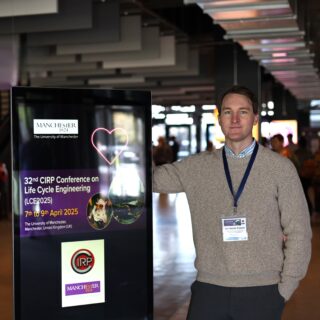32. CIRP Conference on Life Cycle Engineering in Manchester
32. CIRP Conference on Life Cycle Engineering in Manchester
Vom 7. bis 9. April hat Jan Harald Selzam an der 32. CIRP Conference on Life Cycle Engineering teilgenommen. Dort präsentierte er die Ergebnisse des Papers „Chip length control and adjustment through high frequency pulsed cryogenic jet cooling in turning aluminum alloys“ der Autoren Jan Harald Selzam, Trixi Meier und Prof. Nico Hanenkamp.
In diesem wurde untersucht, wie die Spanlänge beim Drehen von duktilen Aluminiumlegierungen durch hochfrequent gepulste kryogene Kühlung beeinflusst werden kann. Die Ergebnisse zeigen vielversprechende Ansätze zur Steuerung und Einstellung der Spanlänge und zur Verbesserung der Nachhaltigkeit des gesamten Bearbeitungsprozesses.
Wir danken dem Organisationsteam für die gelungene Konferenz.
Abstract:
Turning of ductile materials often results in continuous chips due to the lack of chip breaking. These chips have a negative impact on the sustainability of the machining process. Automation and recycling become more difficult, chips can damage the workpiece or machine tool and pose a risk to operator health. Several approaches are being investigated to address the issue of a lack of chip breaking. One of these is the pulsed supply of coolant. Studies have shown that the chip length can be controlled by pulsed high-pressure application of conventional metalworking fluids. This paper applies these findings to carbon dioxide based cryogenic jet cooling when turning aluminum alloys. Due to the typically high cutting speeds in aluminum machining, the coolant pulses are applied at high frequencies to create reasonably sized chips. The influence of the factors material, feed rate, pulse duration, pulse frequency and application angle on the probability of chip breaking and hence chip length is analyzed. The paper shows that pulse-induced chip breaking can be achieved. Depending on the parameters, the chip breaking probability per pulse ranges from 61.7 % to 100 % for EN AW2007 and from 11.7 % to 98.3 % for EN AW 6082. With a sufficiently high breaking probability, the chip length can be adjusted precisely.
Jan Selzam, M. Sc.
Department Maschinenbau (MB)
Lehrstuhl für Ressourcen- und Energieeffiziente Produktionsmaschinen (REP, Prof. Hanenkamp)
- Telefon: +49 911 6507864892
- E-Mail: jan.selzam@fau.de


